Capitalism Lab – Media and Real Estate
Author: Stylesjl
Real Estate and Media
The Real Estate and Media industries are both special industries in Capitalism Lab as they are both not dependent on the production and sale of goods, but instead on providing unique services. To make money with these industries requires a very different strategy to the normal product based industries.
The following guide will explain how to best make money with these industries and under what circumstances you may want to choose to invest in these industries.
Real Estate
Real Estate in Capitalism Lab involves the construction of Apartment or Commercial Buildings and renting out the space to tenants to provide a steady source of income as well as to potentially profit from the price appreciation of the land underneath or around the buildings.
Only companies with a large amount of starting capital and a great deal of patience should attempt to invest in the real estate industry as the returns tend to be slow and relatively small compared to most production industries, but also stable and low risk.
Before constructing your first real estate building you should take a look at the local city’s level of demand for Residential or Commercial space. If the local supply exceeds the demand by a wide margin, then making an investment would be a bad idea, but if supply is below demand then this presents a good opportunity to make money.
To find the supply/demand ratio you can open the City Graphs and quickly glance at the Supply and Demand indexes for Housing and Office Space. A positive number indicates that supply exceeds demand, while a negative number indicates that the demand is much higher than supply. Aim to build in the cities with a negative number:
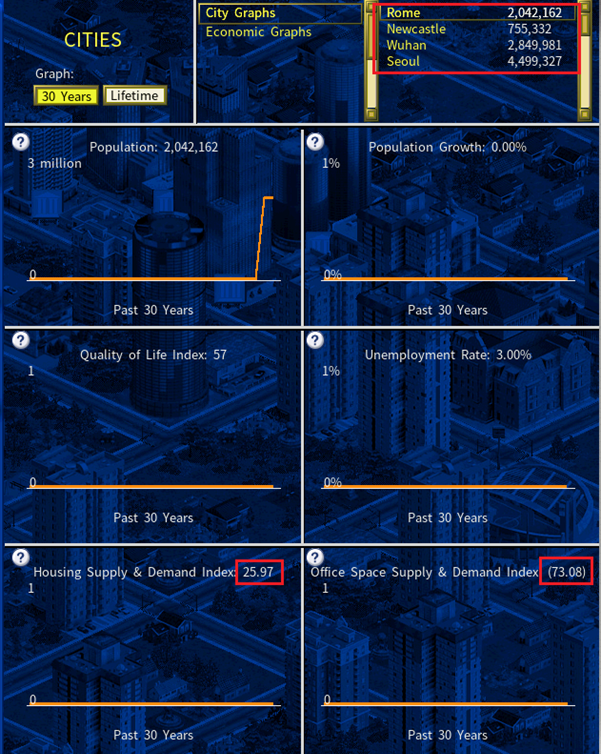
Another way to look at supply and demand is to click on a Commercial or Apartment building and look at the supply/demand lines.
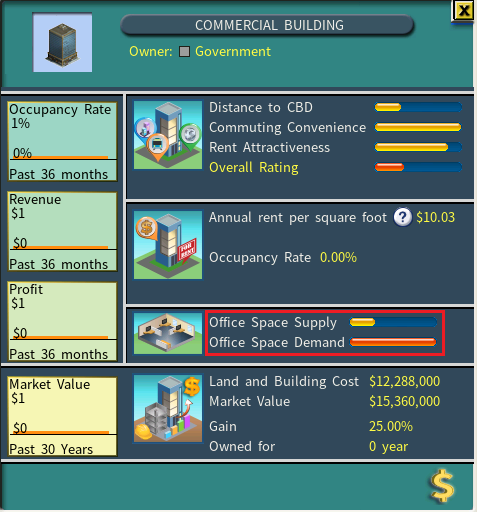
Once you have found the cities where the demand for new apartment or commercial buildings is highest you then need to choose a location. The best locations for new buildings are the following:
Commercial Buildings
- Near the city CBD (to find out where this is, click on an existing commercial building and look at the Distance to CBD, the higher it is, the closer you are to the CBD):
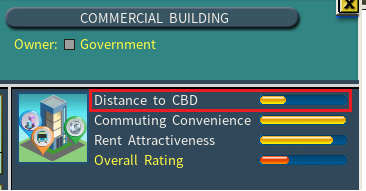
- Close to existing apartment blocks (you will need several of them for the Commuting Convenience bar to completely fill up).
Aim to build commercial buildings close to the CBD and next to apartment blocks (if there are no apartment blocks in the CBD, you can build some yourself).
Apartment Buildings
- Near Community Facilities such as Police Stations, Hospitals, Schools, etc. The more expensive and diverse the Community Facilities, the better.
- Near Sports Facilities (but also, open green spaces nearby can substitute for Sports Facilities).
- Near retail firms (Shopping Convenience).
Generally speaking if you cannot put your apartments in locations with all three traits then the next best locations are near Community Facilities (as these count the most towards Rent Attractiveness), then Sports Facilities (which are less important).
Building apartments near shops will improve the rent attractiveness as well, but it is usually better to build them in areas where Shopping Convenience is low as normally retail shops will be built by other companies nearby to your new apartment blocks (apartments with tenants increase nearby customer traffic).
This is a good example of apartment building placement for the following reasons:
- It is next to a University, Hospital and 3 different Sports facilities.
- Demand is higher than supply for the city as a whole.
- The Shopping Convenience is low but there is still some space nearby to add additional retail stores, which implies that the value can rise further.
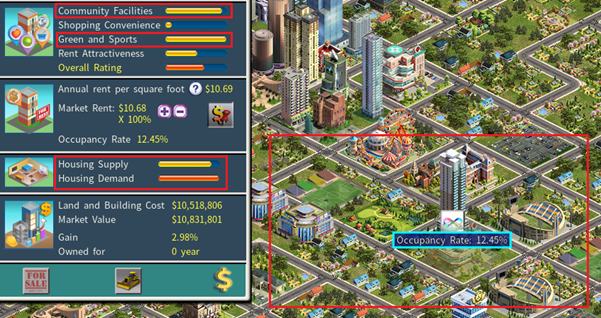
To further improve this it would be ideal to buy nearby land and hold on to it as the price will likely go up when other companies open nearby retail shops and the demand for housing will increase over time. Just be sure to leave enough unowned land nearby for retail shops to be built.
Buying Land
Another important aspect of your Real Estate strategy is land speculation, profiting off of buying land cheap and selling it at a higher price, or reserving land for later use.
The price of land is affected by a variety of factors including the proximity to Community and Sports Facilities, retail shops and other firms, customer traffic levels and the wage rate of the city. Some of these factors you can’t really control but you can still increase the value of your land holdings in the long term.
A good example of this can be seen in many games of Capitalism Lab where the AI Competitors will buy up very large plots of land on the outskirts of a city and slowly add apartments and community facilities to it, effectively creating their own suburb:
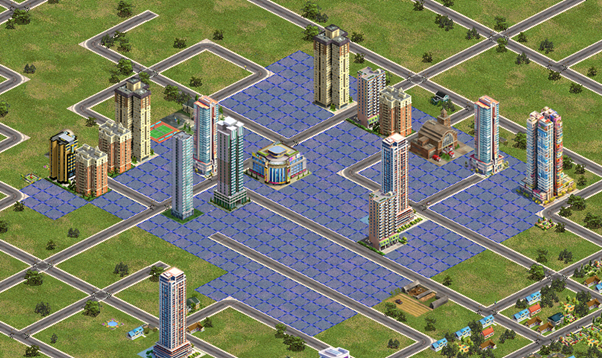
If you look at the AI companies that do this you will notice that they are usually Real Estate or diversified companies with a lot of capital. This strategy works well as by purchasing a large amount of land outside of the city it will very cheap compared to land in the centre of the city, but with plenty of potential to become more expensive later.
However their company may not have enough money or the demand for apartment buildings might not be high enough to justify using all of the land at once so over time they will add more and more buildings and add Community Facilities as well to raise the rental value of the properties.
Sometimes the AI may even create ‘Holes’ in the land they own, where a certain block of land inside their ‘Suburb’ isn’t owned by anyone. This can be a good place for someone else to construct a retail store, which is the likely reason they will do this.
In many cases if the AI Company diversifies you may even notice them building their own shops inside their suburbs as well, boosting the revenue of those stores and raising land values further.
All of these actions are designed to maximise the value of their Real Estate holdings. In effect they buy cheap land, add improvements and buildings slowly to build up the value and then profit from the higher rents and land price increases. If you are building your own real estate empire these strategies may be worth imitating as well. Even if you don’t use all of the land you can still sell it later at a higher price than what you originally bought it for.
Managing Real Estate rents at the headquarters
If your portfolio grows large enough you may consider it worthwhile to construct the Real Estate Department at your headquarters:
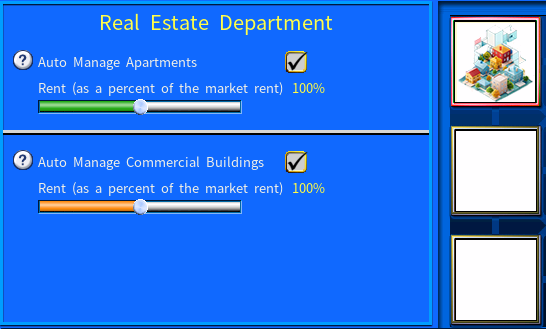
In general your Real Estate rates should in most cases be kept at 100%, but you may want to raise or lower these rates under the following circumstances:
- If demand exceeds supply and there is little competition, raise the rates somewhat above 100% (but not too high).
- If there is a lot of competition and you cannot fill up your buildings to full occupancy then lowering the rates will help attract extra tenants.
Real Estate and the DLCs
City Economic Simulation
In this DLC you can adjust the level of demand for Commercial and Apartment space, changing the profitability dynamics of the Real Estate industry. You can also adjust the land prices:
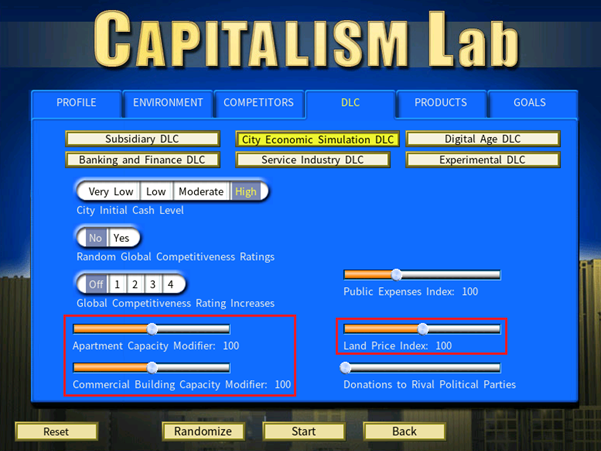
In this DLC you can also run for Mayor of a city and take control of the government. As a result you can add or remove Community/Sports Facilities and relocate retail businesses or other firms. This presents new opportunities to use city funds to benefit your real estate holdings or to harm your competitors (by moving firms away from their land).
See these pages for additional details on how to use these tools:
Service DLC
The Service DLC adds two important changes to Real Estate, Shopping Malls and retail businesses inside Apartment/Commercial buildings.
Shopping Malls are large buildings that can hold many retail and service firms inside them. Shopping Malls are very expensive and take up a lot of land but they can quite lucrative if you have a sufficient number of competitors renting space inside the malls.
Malls will tend to more valuable if the customer traffic levels are higher. Customer traffic can be increased by adding nearby apartment buildings and other firms. If you have a shopping mall it is a good idea to put your apartment buildings next to it as it raises the Shopping Convenience rating of the apartments and it drives more customers to the mall, raising the value of both firms.
Customer traffic can also be increased by adding more stores to the mall; each new mall tenant will drive additional traffic to the mall, benefiting all of the other tenants and the mall owner.
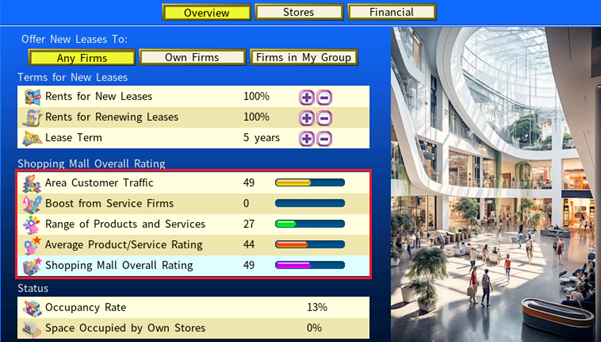
To drive additional traffic to the mall, it may also be worthwhile to decrease the Rents for New Leases % to a lower level to attract new tenants. Once they are in the mall you can then charge higher rents after the Lease Term expires. You can even add your own stores to the mall to further boost traffic.
Apartments and Commercial Buildings can have Retail Space in the Service DLC as well if the option is toggled:
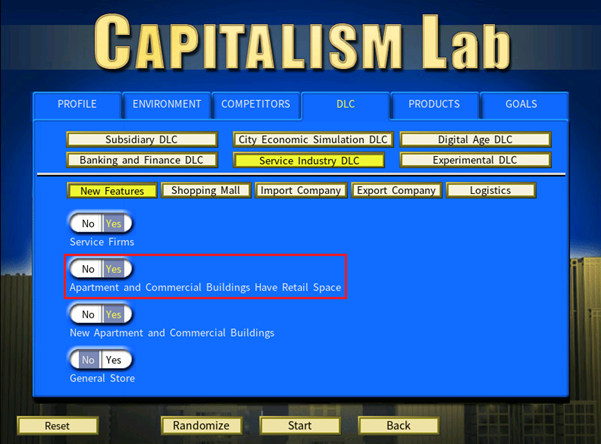
This means that instead of setting up stores inside of malls or buying land for the store you can just use the space inside the Apartment/Commercial Building. This can be a useful supplement to your Real Estate strategy as you can setup some shops inside apartments or commercial buildings and import goods from competitors or the seaport with a smaller than usual level of overhead:
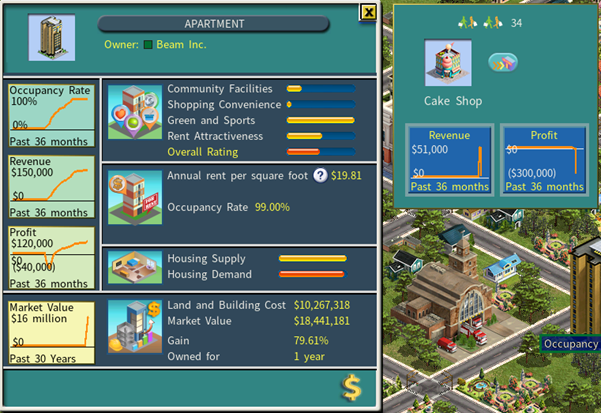
It should be noted that only the owner of the building can use the space to setup a store, competitors cannot rent the space in your buildings (nor can you rent space in theirs).
Other notes about Real Estate
- The earlier you start the better. Demand usually exceeds supply at the start of the game and competition will usually create excess supply. This is especially true if your competitors start with a large amount of capital.
- Be careful about taking out loans, the interest rates may exceed the rental returns in some cases, which can bankrupt you.
- If you do employ the strategy of building your own ‘Suburb’ then the best places to do it are usually in low wage rate cities as this is where the land is cheapest (and has the most potential to increase in value).
- If you increase or decrease the rent the rates paid will take several months to change so don’t expect immediate jumps in profit after making improvements or changing the rent prices. In the case of Service DLC Shopping Malls the time frame is even longer at a minimum of 5 years before the rent can be changed.
- Real Estate is typically resistant to recessions, so it can be a good way to diversify your portfolio and reduce the volatility of your profits/revenue.
- Purchasing land can work as a good hedge against inflation; if you hold your money in land it will typically hold most, if not all of its value.
Media
In Capitalism Lab you can use Media firms to generate revenue via advertising through Newspapers, Radio Stations and Television. Media firms are very expensive to build and take a long while to generate any profits, but once established they can become very profitable for the company that owns them.
Revenue from media is generated via two different advertiser types: Corporate advertisers and Local Advertisers. A Corporate advertiser is when a competitor or one of your own firms spends money on advertising their brand. A Local Advertiser consists of people or businesses within the population of the city advertising with your media firm. The share of local and corporate advertisers is displayed in the pie chart of the media firm:
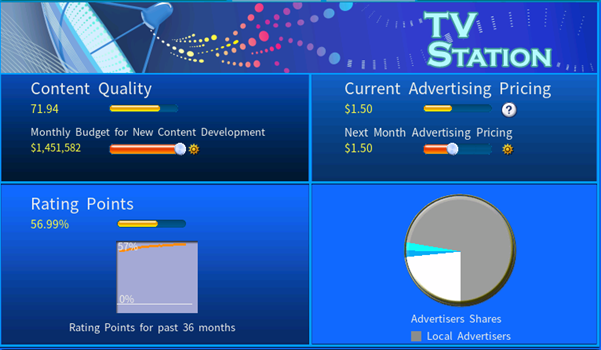
The likelihood that local advertisers and corporate advertisers will choose your media firm for their advertisements depends on two factors:
- Rating Points
- Advertising Price
The higher the ratings, the more impact each advertising dollar has on improving the brand being advertised and so all other things being equal a company will always choose the media firm with the highest ratings if the advertising price is the same so having a high rating is very important:
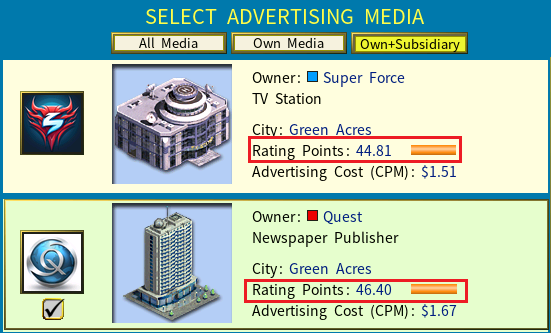
To increase the Ratings you need to spend money on improving the content of your media firm over a long period of time, the more you spend the higher the Content Quality and therefore the higher the ratings:

Ratings are also limited by competition, if there are more competing media firms it will be harder to achieve a high rating as you will be competing for viewers. The budget will also scale with the size and wage level of the city you are trying to cover as well; a bigger and more prosperous city requires a bigger budget to get the same rating increase.
Likewise the more expensive media firms such as a Television Station will require a bigger budget than a Newspaper Publisher to achieve the same ratings. However the main advantage of using a more expensive media firm is that you can sell more advertising in total.
Once the rating reaches a very high level, it will be much harder for the rating to increase further, even with the budget set to the maximum level; at this point it may become unprofitable to continue trying to push the ratings higher, it may be better at that point to reduce the budget to avoid wasting money.
The most optimal strategy from my own experience is to build a new media firm and then set the budget to the highest level for several years and once the ratings stop increasing or rise only very slowly to then reduce the budget to the point that the ratings remain stable. Another alternative is to buy an existing media firm with already established ratings and set the budget to maintain those ratings.
The Advertising Price is how much an advertiser needs to pay for a certain number of impressions. A higher price can increase your profits per advertiser but it will also make advertisers less likely to choose your firm, reducing your overall profits.
It can be tricky to get the right advertising price for your media firm as it will only take effect at the end of the month and your advertisers are very price sensitive. The best way to get the right price is to check the pie graph of advertisers in your media firms as well as competitors in the same city. For example this pie chart indicates that the price is too high as there is only a small amount of local advertising and no corporate advertisers:
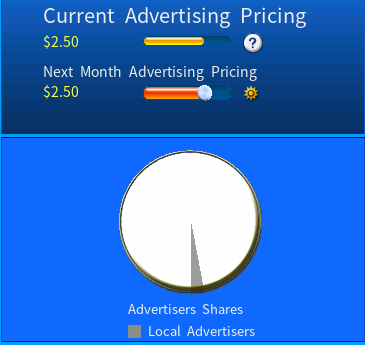
But what price should I set to attract advertisers while still making a profit?
Take a look at the competing firms (in the same city) to find out:
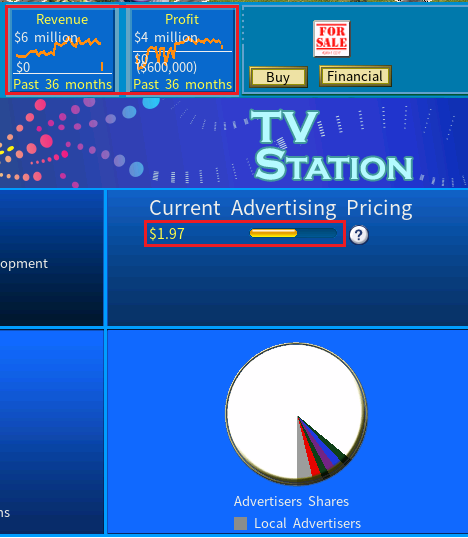
As you can see in the screenshot above, they are getting some advertisers and they are making a profit as well. Their price is about $2. I should try undercutting my competitor by setting an even lower price. After waiting a few months I am getting a lot more advertisers:
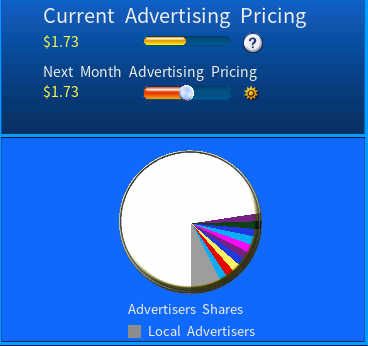
It may be possible to lower the price even further to fill up more of the white space in the pie chart, however in many cases there might not be enough advertisers in the city to do this and also it is possible to lower your prices so much that your media firm becomes unprofitable, so you will have to experiment to achieve the right balance.
If you have persistent problems with too much unused advertising space then you may want to try creating a cheaper media firm (such as a Radio or Newspaper), although building the ratings of those firms up again will still be expensive.
Use your media firms for free advertising
One important benefit of owning a media firm is that you can advertise through them or force your subsidiary corporations to do the same. All of the money you spend will be revenue and profit for your media firm, saving you from losing any money from advertising with someone else’s media firm:

Do keep in mind however that if you spend too much money on advertising within your own corporation you may potentially run out of advertising space that other advertisers might otherwise pay for, such as in this example where my own advertising is crowding out the Local Advertisers:
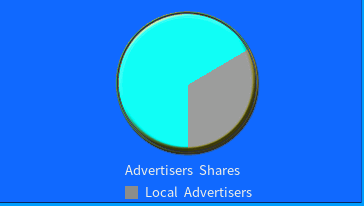
For more information on media firms see this page:
Media and Advertising in the Digital DLC
The Digital DLC introduced two changes to how media works in Capitalism Lab. These changes are:
- The addition of Internet Advertising
- Disruption to Traditional Media
Internet firms are capable of advertising in a similar way to media companies, but with a few important differences including the fact that internet advertising can establish a brand in all cities instead of just one and also internet based advertising relies on both R&D and a content budget:

In addition internet firms can also advertise themselves as well, including with traditional media:
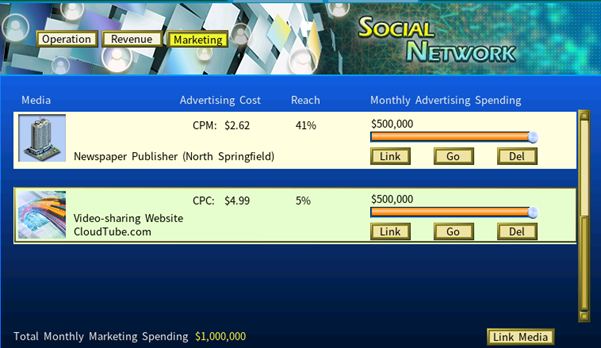
As a result of this DLC Media firms will be less profitable in general as they are now forced to compete with internet advertisers, however this can also be made worse by the difficulty setting called Disruption to Traditional Media which will also reduce the ratings of Media firms in the Digital DLC over time:
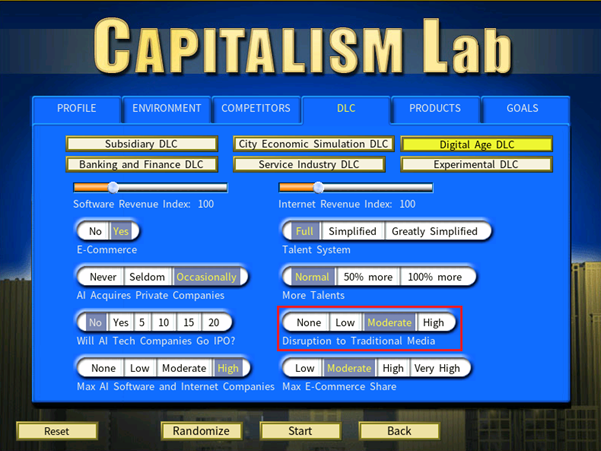
It is still profitable in Digital DLC to use traditional Media firms, but it will be more challenging. For internet advertising the same rules apply as they do for traditional media, keep a high rating (or Reach in this case) and don’t charge too much for advertising.
You can also use your media firms as free advertising for your internet firms as well, using the ratings of your media to increase the reach of your internet company!
For more information on different advertisers in the Digital DLC see this page:
